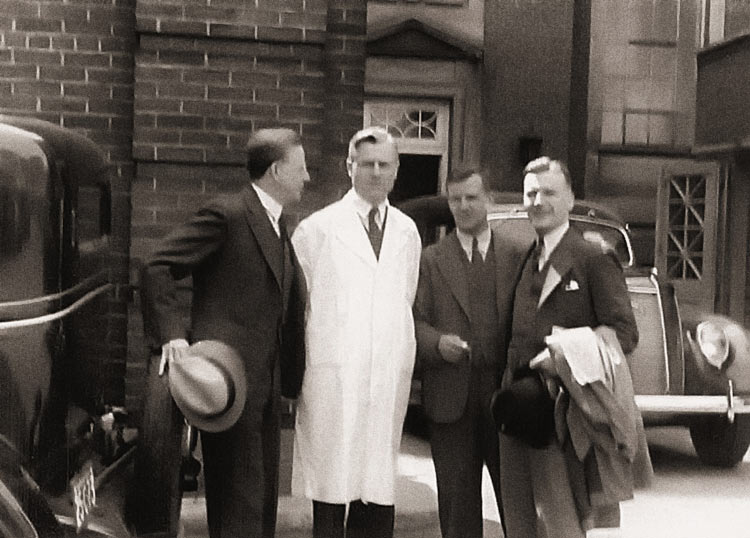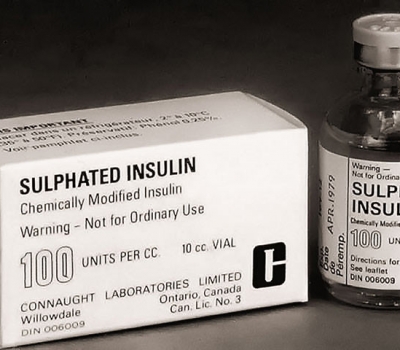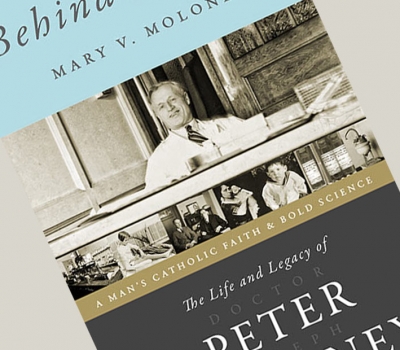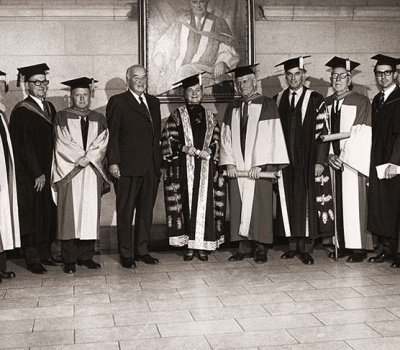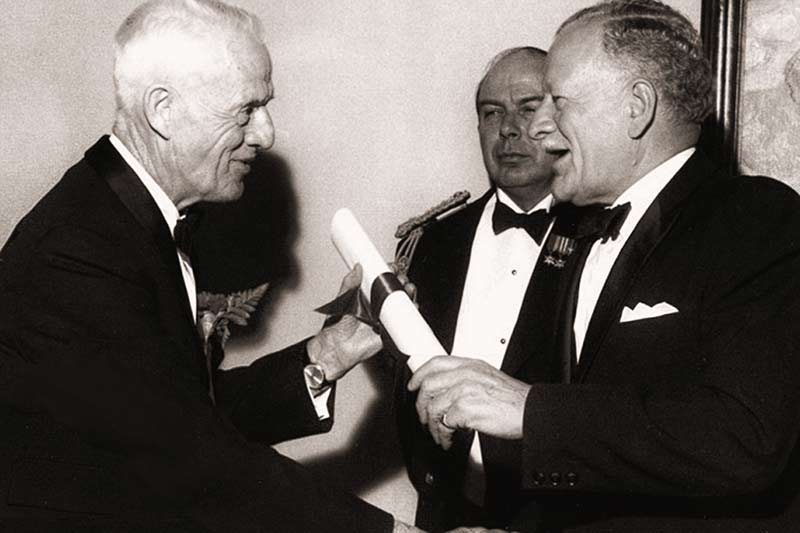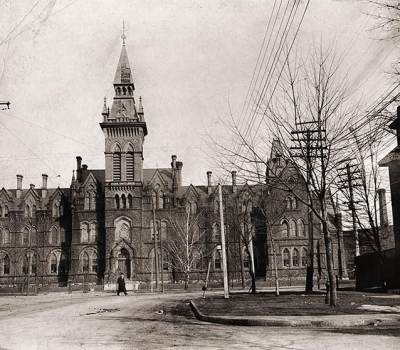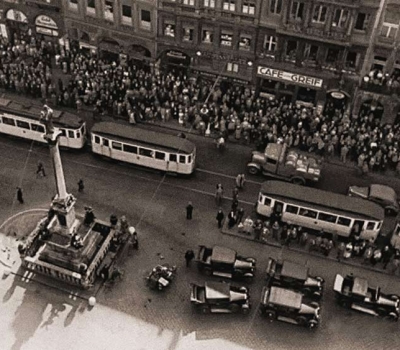
Peter Joseph Moloney, eminent scientist, of world renown, was the first to purify safe insulin in 1922, thus providing safe injections to the world community in the months following its first clinical trials at Toronto General Hospital, and securing lasting fame for its discoverers Banting and Best.
[ This article is under development but published here in draft form for reference to other researchers. ]
At the 50th anniversary of discovery of insulin, C. H. Best and P. J. Moloney received honorary doctorates from the University of Toronto....
Into the Past: Finding Reliable Sources...
Dr. Moloney’s Ph. D. thesis “On the Purification of Insulin” published 1921 according to Canadian Journal of Public Health June 1962 (University of Toronto records give the convocation date 1924, 1921 is very likely a misprint) is available at the University of Toronto. A copy is kept at Sanofi Pasteur on Steeles Ave. Toronto (formerly Connaught Laboratories) and the cover was photographed and posted on their website, it does not show a date.
Research at the U of T Rare Book Room in February 2011 produced some curious observations. The index card for his Ph. D. thesis gave the incorrect date 1930. When the file box was brought which should have contained his Ph. D., his name on the folder inside the box was misspelled Monoley. Inside the file was an article written with an assistant, Findlay, and on its cover was stamped 1930, the date of acquisition by the University of Toronto Library. This was not the date of the article, which is September 1923. The Ph. D. was not in the file.
One source often quoted as the definitive text about insulin is 'The Discovery of Insulin' by Michael Bliss (University of Toronto history professor, McClelland and Stewart Limited, Toronto: 1982). Some archival newspaper articles were obtained online. Dr. Barbara Hazlett, former head of children’s diabetics at Toronto General Hospital, who knew and admired Dr. Moloney, used Bliss’s book as her source for Chapter 1 Historical Perspective: The Discovery of Insulin in the book Clinical Diabetes Mellitus. (Clinical Diabetes Mellitus, A Problem Oriented Approach by Dr. John K. Davidson, Thieme Inc., New York: 1986) (Hazlett used 2 references for this chapter: Michael Bliss’s book The Discovery of Insulin 1982, and her own article about the first injections of insulin administered to Leonard Thompson, in N Engl J Med 306:340-343, 1982.)
At the Clinical Diabetes Mellitus web page, one can view Chapter 1 by Dr. Hazlett. On the right a very small tab brings up a small insert: “Page 7 By mid-May 1922 probably because of a small adjustment in pH the producers gained the ability to make insulin in quantity, and Dr. Peter Moloney, a chemist…” The note stops there, and the entire page 7 has been omitted from the on-line book preview. In the book copy Clinical Diabetes Mellitus, in Chapter 1 on page 6: “Macleod named the extract “insulin” from the Latin word meaning “island.” ...Production of insulin in quantity was undertaken by the Connaught Anti-toxin Laboratories. Initially, the results were disastrous. Nothing worked when production of large quantities was attempted. Diabetics were dying in the spring of 1922 from lack of insulin. By mid-May, probably because of a small adjustment in pH, the producers gained the ability to make insulin in quantity and Dr. Peter Moloney, a chemist, joined the team.” The author stated that Best did not know chemistry at the time; the only other chemist in the building was Dr. Moloney. On May 16 Dr. Banting was appointed to Christie Military Hospital Diabetic unit (University of Toronto Rare Book Room interactive timeline), most likely with insulin to administer to diabetic patients there.
Dr. Moloney had produced a quick acting pH electrode in 1921 that more than likely assisted in detection of pH so that it could be appropriately adjusted. [June 1921 Connaught Laboratory, University of Toronto: Quick acting hydrogen electrode, long before ph meters were generally available, first achievement of Dr. Moloney to gain international recognition]. The conjecture about adjustment in pH cannot be easily verified; we do know something, the title of Dr. Moloney's Ph.D., "On the Purification of Insulin". We can hear of Dr. Moloney's work from Banting himself. On another web page, in an article from History of Medicine entitled The Discovery and Preparation of Insulin by Dr. F. Banting (Feb 1924, originally published in University of Toronto Medical Journal 1(3): 94-98), he states: “The first insulin administered to diabetic patients in the Toronto General Hospital was prepared from normal ox pancreas by the original method. This material exerted a definite effect upon the blood sugar and sugar excretion of a diabetic patient. Certain objectionable effects, however, were observed,which were undoubtedly due to the large percentage of protein which this extract contained. Professor Collip with the knowledge of the properties of the material which we had obtained and with some additional information which he secured by very extensive work, was able in avery short time to purify the original extract so that much of the objectionable inert material was eliminated.
The results of the short study of the clinical effects of this material were reported by Drs. Campbell and Fletcher of the Toronto General Hospital,in collaboration with Professor Collip and ourselves. It will not be possible, in the space at our disposal, to review in detail the various modifications and improvements which have been introduced in the methods of preparation of insulin. A brief summary of some of the more important contributions is submitted. Insulin was originally prepared from the ox pancreas, as stated above, by the extraction of fresh glands with faintly acid alcohol. The concentration of alcohol in our original experiments varied from 40 to 60 per cent. The alcoholic solution of pancreas was filtered and the filtrate concentrated by evaporation of the alcohol and water in a warm air current. Lipoid material was removed by extracting the residue with toluene or ether. The resulting product was the original whole gland extract. We were able to show that the active material contained in this extract was practically insoluble in 95 per cent alcohol. Professor Collip used acid alcohol as the initial extractive but raised the concentration to about 80 per cent. By this means certain inert objectionable materials were removed. The inert materials were filtered off and the insulin precipitated from the alcoholic solution by raising the concentration of alcohol to approximately 92 per cent. The precipitated material was dissolved indistilled water. Certain difficulties were encountered when it was attempted to apply this method to a larger scale production and various modifications were introduced by the workers in the Connaught Laboratories in the spring of 1922.
It was found that the final product obtained by these methods was not sufficiently pure for prolonged clinical use, and efforts were made to secure a better product. The benzoic acid method of Moloney and Findlay which depends upon the fact that insulin is absorbed from watery solution by benzoic acid was successfully used in the Connaught Laboratories for several months.” This is one of the very few sources which states the contribution of Dr. Moloney. This contribution is not widely known, and is of pivotal importance in the history of the discovery of insulin. James Fitzgerald states in his book “What Disturbs Our Blood”, that diabetics poured into Toronto in summer 1922. Why were they pouring into the city? Word had leaked out that insulin was available. We can rightfully conclude, from Banting’s own words, that Dr. Moloney’s insulin was available which Banting says was successfully used for several months. Dr. Moloney stated in his 1974 interview that several thousands of doses were supplied by this method, and this agrees with Banting's statement above. This information is not widely known. Hazlett page 6-7: “Eli Lilly [a U. S. firm] began to supply physicians across the U. S. Joslin received his first supply on August 6, 1922. Frederick Allen got his first batch 2 days later. By the end of August, both Lilly and Connaught were producing good insulin. There were serious attempts to purify insulin in 1922. "After a few months delay, Best took up the problem of production and refinement…. But by Jan. 1923 as a result of work carried out in Connaught Laboratories, we were able to provide insulin to about 250 clinicians.” (from Banting Digital Library web page, page 4-5).
According to Dr. B. Hazlett, Best did not know chemistry. Collip purified some insulin himself, and results from clinical trials were reported to Drs. Campbell and Fletcher of Toronto General Hospital as successful use of the new medicine...Piecing Together the Truth...Later Banting says “certain difficulties were encountered when it was attempted to apply this method [from Collip] to a larger scale production and various modifications were introduced by the workers in the Connaught Laboratories in spring 1922. It was found that the final product obtained by these methods was not sufficiently pure for prolonged clinical use. The benzoic acid method of Moloney and Findlay (refer to the Ph. D. thesis of Dr. Peter Joseph Moloney, it was his original idea to use benzoic acid) which depends upon the fact that insulin is absorbed from water solutions by benzoic acid, was successfully used in the Connaught Laboratories for several months.” In the British Medical Journal Vol. 287, 3 Dec. 1983 Page 1695, an article titled Amateur, Nobel, Scientists, author Robert Tattersall states that “Elizabeth Hughes, daughter of a prominent U. S. politician (the Secretary of State) who developed diabetes at age 11 in 1918… bubbles with enthusiasm about wonderful Dr. Banting whose injections on 25 August 1922 [in Toronto], enabled her to eat her first piece of bread in 3 ½ years.” Very likely, Dr. Moloney produced this insulin.
Later Banting says, “D. A. Scott and Best, who are responsible for preparation of insulin in the Insulin Division of Connaught Labs, have tested all available methods and have appropriated certain details from many of these.” Dr. Moloney’s name is not mentioned but it is clear he produced the first successful, widely used insulin.The University of Toronto interviewed Dr. Moloney for its Oral History Program and he stated on page 16 of the published interview transcript that his benzoic acid method gave “several thousands of doses…. It was an idea I’d brought back from my work on hippuric acid.” (In Dr. Moloney's own handwritten edited copy of the interview transcript we read, after the encounter with Banting..."Later I had associated with me Don Findlay. We developed a method for the purification of insulin which was an outcome of the work I had done with hippuric and benzoic acids. In the hospital undesirable reactions were being induced by the insulin available and the method we had devised gave a better product.. I suppose there were some thousands of doses of insulin purified by the benzoic acid method given. " This edited version was never published by the University of Toronto.) His work on hippuric acid refers to his work in Ottawa at the Department of Agriculture a few years before, in 1918, in which he was able to produce benzoic acid at very high yield and very inexpensively.
Dr. Moloney showed samples of this work to Dr. Miller of U of T, which so impressed him that he spoke of the work of Dr. Moloney to Dr. Fitzgerald, and Fitzgerald hired him immediately as the first chemist at Connaught Laboratories in 1919...The Rush to a Nobel Prize 1923...The mysterious silence persists to today. Moloney’s work was not an insignificant contribution. It revived hope in Banting who was avoiding the laboratory in those days before mid-May 1922. It was evident from Banting’s paper quoted earlier that it was Dr. Moloney who successfully produced insulin for several months beginning in spring 1922. Dates are noticeably left out of most accounts, where they speak of a month such as mid May or just spring. It is also evident that most sources of the history of insulin leave out Moloney’s name and contribution, so vital at the time. On October 25, 1923, the Nobel prize was awarded to Banting and Macleod. This is a short period of time for the decision to award the Nobel Prize. Consider the gap of years for Sir Henry Dale, who identified acetylcholine in 1914, and was awarded the Nobel Prize in 1936.
The Nobel Prize was hastily bestowed October 25, 1923 to Banting and Macleod, Banting was unaware of the news, learning of it after it had hit the papers October 26 (according to one account). According to Hazlett in Clinical Diabetes Mellitus page 4: “In October 1921, Banting suggested to Macleod that Collip, also 29, by then back in Toronto and working in the field of pathologic chemistry, be invited to help purify their extract. They also talked to Dr. J. G. Fitzgerald, the director of the Connaught Anti-toxin Laboratories, hoping for some assistance. [This assistance would have been Dr. Moloney] Macleod encouraged the two to work alone until they had a clear solution. In October 1921, for the first time Banting and Best reviewed the literature while waiting for the pancreas to atrophy in dogs in which they had ligated the ducts. As previously mentioned, Paulesco had worked on pancreatic extracts; his results had been published in French, a language which neither Banting nor Best could read well. Thus, they misunderstood Paulesco’s writings. By some misadventure, they also missed the writings of Zuelzer and E. L. Scott. Macleod asked the two young men to give a preliminary report of their work at the Physiological Journal Club on November 14, 1921.”It is clear that the Nobel Prize was hastily given on October 25, 1923 because Banting was not even aware when it was given; recall also that Collip left Toronto in mid May of 1922. Doctor's requests for insulin was being supplied by Dr. Moloney’s insulin for several months, according to Banting, “several thousands of doses” in Dr. Moloney’s own words, for that summer of 1922.
Dr. Moloney produced an article “On the Purification of Insulin” in 1923, and an earlier (perhaps) Ph. D. thesis 'On the Purification of Insulin'. The remaining years of his career prove his eminence as a scientist. Given the attempts to obscure the contribution of Dr. Moloney, these attempts lead to the question, why was this done? Why did learned men obscure Dr. Moloney’s important contribution, in those days of 1922 when the world was thirsting for insulin?...Questions Remain...Why are the discoveries of Collip (clam insulin) and Macleod (fish insulin) proclaimed by the press in archival sources, 1922, when in fact the very first safe usable insulin available in large amounts was prepared by Dr. Moloney in 1922, and nothing of Moloney’s work appears in 1922 archival press? It is known that from 1922 Dr. Moloney received many requests from Russia for insulin. He never mentioned the events surrounding insulin, and only spoke of the wonder of medical discoveries, of gratitude to Dr. Fitzgerald and co-workers, and of fascination with his work: "My work is my hobby."
Sign the Petition :
Recognition for Heroic Canadian Scientist Dr. Peter Moloney | https://www.ipetitions.com/petition/recognition-for-heroic-canadian-scientist-dr

